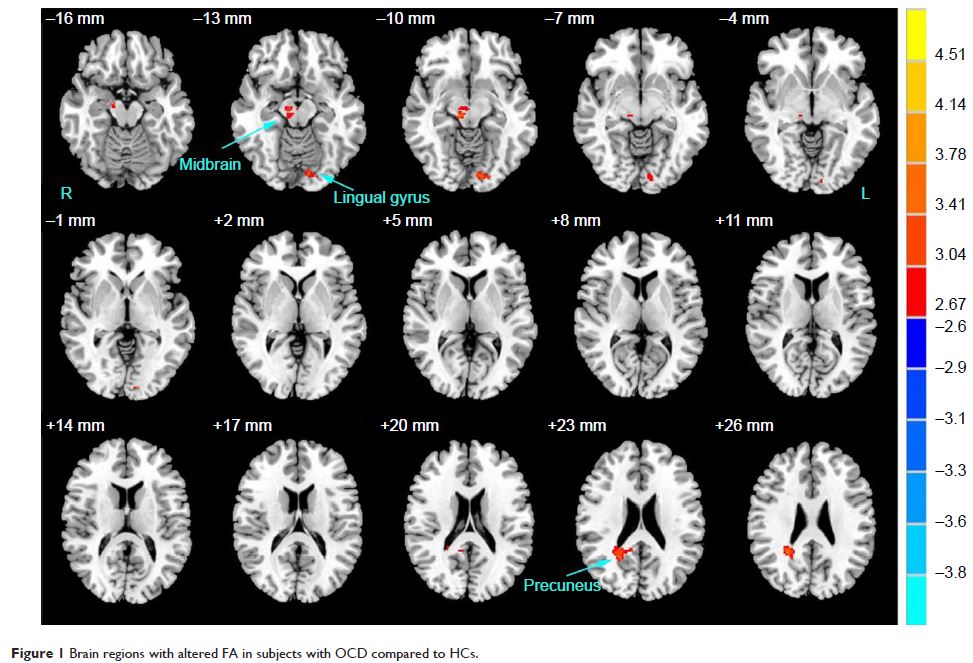9 7 4 9 1
论文已发表
注册即可获取德孚的最新动态
IF 收录期刊
- 3.3 Breast Cancer (Dove Med Press)
- 3.4 Clin Epidemiol
- 2.5 Cancer Manag Res
- 2.9 Infect Drug Resist
- 3.5 Clin Interv Aging
- 4.7 Drug Des Dev Ther
- 2.7 Int J Chronic Obstr
- 6.6 Int J Nanomed
- 2.5 Int J Women's Health
- 2.5 Neuropsych Dis Treat
- 2.7 OncoTargets Ther
- 2.0 Patient Prefer Adher
- 2.3 Ther Clin Risk Manag
- 2.5 J Pain Res
- 2.8 Diabet Metab Synd Ob
- 2.8 Psychol Res Behav Ma
- 3.0 Nat Sci Sleep
- 1.8 Pharmgenomics Pers Med
- 2.7 Risk Manag Healthc Policy
- 4.2 J Inflamm Res
- 2.1 Int J Gen Med
- 4.2 J Hepatocell Carcinoma
- 3.7 J Asthma Allergy
- 1.9 Clin Cosmet Investig Dermatol
- 2.7 J Multidiscip Healthc

未服药的强迫症患者白质部分各向异性的变化
Authors Tao J, Wang XL, Zhong ZY, Han HY, Liu S, Wen SL, Guan NH, Li LJ
Received 1 October 2016
Accepted for publication 8 November 2016
Published 28 December 2016 Volume 2017:13 Pages 69—76
DOI https://doi.org/10.2147/NDT.S123669
Checked for plagiarism Yes
Review by Single-blind
Peer reviewers approved by Dr Colin Mak
Peer reviewer comments 3
Editor who approved publication: Professor Wai Kwong Tang
Background: Abnormalities in white matter (WM) have previously been reported in
patients with obsessive–compulsive disorder (OCD). However, there was some
inconsistency in the results obtained for altered regions of WM. The aim of
this study was to investigate fractional anisotropy (FA) in the WM of the whole
brain in patients with OCD by using diffusion tensor imaging (DTI).
Methods: In total, 28 unmedicated patients with OCD and 28
healthy volunteers underwent DTI scan. A voxel-based analysis was used to
compare FA values in WM of the two groups at a voxel threshold of P<0.005 with an
extent threshold of k >72 voxels (P <0.05; Alphasim correction).
Subsequently, correlation analysis was conducted in order to find the
correlation between the mean FA values in significantly altered brain regions
and Yale–Brown Obsessive Compulsive Scale (Y-BOCS) scores of the OCD patients.
Results: Compared with healthy volunteers, the OCD patients had
lower FA value in the left lingual gyrus, right midbrain, and right precuneus.
There were no regions with significantly higher FA values in OCD patients
compared with healthy volunteers. The mean FA values in the above regions (left
lingual, r =0.019, P =0.923; right
midbrain, r =-0.208, P =0.289; and right precuneus, r =-0.273, P =0.161) had no
significant correlation with the Y-BOCS scores of the OCD patients.
Conclusion: The findings of this study suggest that alterations in
WM of the left lingual gyrus, right midbrain, and right precuneus are
associated with the pathophysiology mechanism of OCD, and these microstructural
alterations do not correlate with symptom severity of OCD.
Keywords: white matter, diffusion tensor
imaging, fractional anisotropy, obsessive–compulsive disorder
